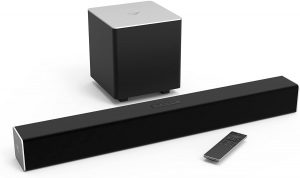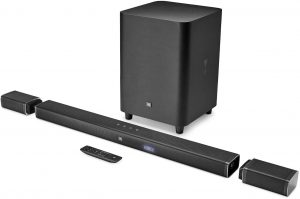
5.1 channels are the industry standard for surround sound, but is it always better? Could you save money by going for a 2.1 channel soundbar and enjoy your media just as much? Let’s answer this and more as we compare 2.1 VS 5.1 soundbars below.
2.1 or 5.1 Soundbar?
- More compact
- Easier setup and placement
- Comes with an affordable price
- Support HDMI
- Bluetooth connection is common
- True surround sound
- Center channel for clear dialogue
- Has rear satellite speakers
- Built-in Bluetooth and WiFi
- Multiple connectivity options
Features Comparison: 2.1 VS 5.1 Soundbars
Just how different can a 5.1 VS 2.1 soundbar be? Let’s delve deeper into the features to understand the distinction better.
You can also check our review of the LG NB4543 that sits in between at 4.1 channels.
Design
A 2.1 channel soundbar only features 2 channels, with one on each side. Meanwhile, a 5.1 channel soundbar has 2 side channels and a center channel plus two rear speakers. The rear speakers could be built-in or external.
As one would imagine, the more channels you have, the larger a soundbar would be. The 2.1 system is a good choice for those who want a noticeable upgrade from their standard TV speakers, but don’t necessarily need total enveloping sound.
2.1 soundbars are also the better choice for smaller spaces due to their more compact profile. Being lighter than the alternative, they can be wall-mounted much more easily. Even subwoofers[1] that come with 2.1 soundbars are quite slim as well.
The small size and lightweightedness of the 2.1 option offer more flexibility in terms of placement and moving around.
Meanwhile, a 5.1 soundbar could come with many parts, which calls for a larger surface. For this reason, a 5.1 soundbar is better suited to larger rooms and TVs. Those with bigger sound requirements might also find 5.1 soundbars the more attractive option.
A 5.1 soundbar with an external subwoofer and external rear satellite speakers can offer users customization for their home theater system. They can experiment with the placement to find the best setup for the room.
As for the exterior design, some soundbars may have an LCD display screen or control panel built-in for better readability of your input settings. While this may not be necessary, we have found that it makes setup easier.
Price
Due to the potential for better surround sound quality and dialogue clarity, a 5.1 soundbar is usually much more expensive than a 2.1. Occasionally they can be a little under a thousand dollars, but there are soundbars worth a lot more.
However, if you are not an audiophile, a 2.1 system with advanced audio technology and a 5.1 system with basic sound capabilities may offer little difference in your viewing experience. It can also save you money in the process.
Sound Quality
A single soundbar alone may not provide you with satisfactory surround sound experience. But with the addition of a subwoofer, multiple channels, and advanced technology, you could bring a theater home with you.
Just by looking at the numbers, a 5.1 soundbar is expected to offer much more in return than a 2.1. The additional center channel for dialogue clarity and the two rear speakers can provide a richer listening experience with or without added technology.
You can also create more depth with a 5.1 system if there are 3 external speakers (2 satellites and a subwoofer) by experimenting with their placement in the room.
However, if that’s all the soundbar system has to offer, there may be little stopping a 2.1 soundbar with impressive Dolby technology to outperform it.
Dolby Audio is renowned in the entertainment industry as the leader in perfecting sound. Soundbars can come with Dolby Atmos, various forms of DTS technology and other software unique to specific brands. They don’t have to be expensive too, as proven by our favorite Dolby Atmos soundbars with the cheapest price tags.
The addition of these technologies in a soundbar will instantly elevate the audio quality regardless of the number of channels.
Aside from hardware and software, both 2.1 and 5.1 soundbars can come with sound modes. These are pre-tuned settings in a soundbar that enhance certain content. Common sound modes you can find include movie, news, music, gaming and sports modes.
Connectivity
In order to support high-quality content and high-tech audio decoders, both 2.1 and 5.1 soundbars can come with an HDMI connection. HDMI supports 4K passthrough and handles a larger load than other cables.
If your soundbar lacks HDMI like the Sony HTCT180, digital optical connection is your next option. Digital optical is also capable of 4K passthrough. It is more prevalent in soundbars than HDMI.
It’s important to make sure both your TV and soundbars have compatible input and output ports to connect the devices.
Bluetooth
Bluetooth is the most common form of wireless connection offered by all soundbars. You can even find it in top-performing 2.1 wireless speakers and soundbars. Whether it’s enabled in a 2.1 or 5.1 soundbar, Bluetooth allows users to stream content from their mobile devices to unlock previously inaudible frequencies.
Voice Assistant
Voice assistants such as Google Assistant and Amazon Alexa are fancy features that won’t affect the performance of your soundbar. However, these allow simple hands-free control of the soundbar and will be able to give you fast information such as weather and news reports.
Control
2.1 and 5.1 soundbars usually come with their own remote controls, while some can be configured to work with universal remotes. Soundbars with a control panel built onto the interface will allow you to perform basic controls.
You can also control your soundbar through your TV remote.
Setup
The top 2.1 wireless speakers or even 2.1 soundbars are easier to set up simply because they have fewer components. If you have a 5.1 soundbar with rear satellite speakers, those are just two more parts of the system you have to sync.
Both HDMI and digital optical cable connections offer a fair amount of ease, thanks to their plug-and-play design. Moreover, everything you need should come inside the box, which includes the remote, cables, and user manual. Occasionally, a soundbar purchase will also come with a wall mount kit.
Have an LG soundbar? We have a thorough guide on how to setup your LG soundbar here.
Our Top Picks For 5.1 & 2.1 Soundbars
VIZIO 2.1 Sound Bar SB2821-D6 with Wireless Subwoofer
This 2.1 soundbar is the perfect example of what we meant by fewer channels and more audio technology to create an exceptional device.
Unlilke Vizio M21D-H8R, the Vizio 2.1 soundbar comes with Dolby Digital, DTS TruSurround, and DTS TruVolume to deliver sound effects and acoustics that will exceed your expectations.
JBL Bar 5.1 4K Ultra HD 5.1-Channel Soundbar
Supporting 4K and Ultra HD content audio, the JBL Bar 5.1 can fully envelop viewers with high-definition sound. With the help of Dolby Digital, Dolby Pro Logic II, and DTS technology, all content played onscreen will come to life.
The JBL Bar also gives you the flexibility to choose between the 3.1 and 5.1 systems and comes pre-tuned for incredible sound.
Curious about which models are considered cream of the crop? Check our list of soundbars that get the most expert approval, next!
The post 2.1 VS 5.1 Soundbar appeared first on The Product Analyst.
from The Product Analyst https://theproductanalyst.com/soundbar/2-1-vs-5-1/




No comments:
Post a Comment